Tourism Consumer Behaviour & Insight: Virgin Holidays - HND Level 5
VerifiedAdded on 2023/06/15
|12
|3645
|369
Report
AI Summary
This report provides an analysis of tourism consumer behavior and insight, focusing on Virgin Holidays. It examines factors influencing consumer behavior, the impact of digital technology on consumer trends, and the stages of the consumer decision-making journey. The report also compares B2C and B2B approaches, explores market research methods, and discusses the role of marketers in the tourism decision-making process. It emphasizes the importance of understanding consumer behavior for effective marketing strategies in the tourism sector. Desklib provides access to this and other solved assignments to aid students in their studies.
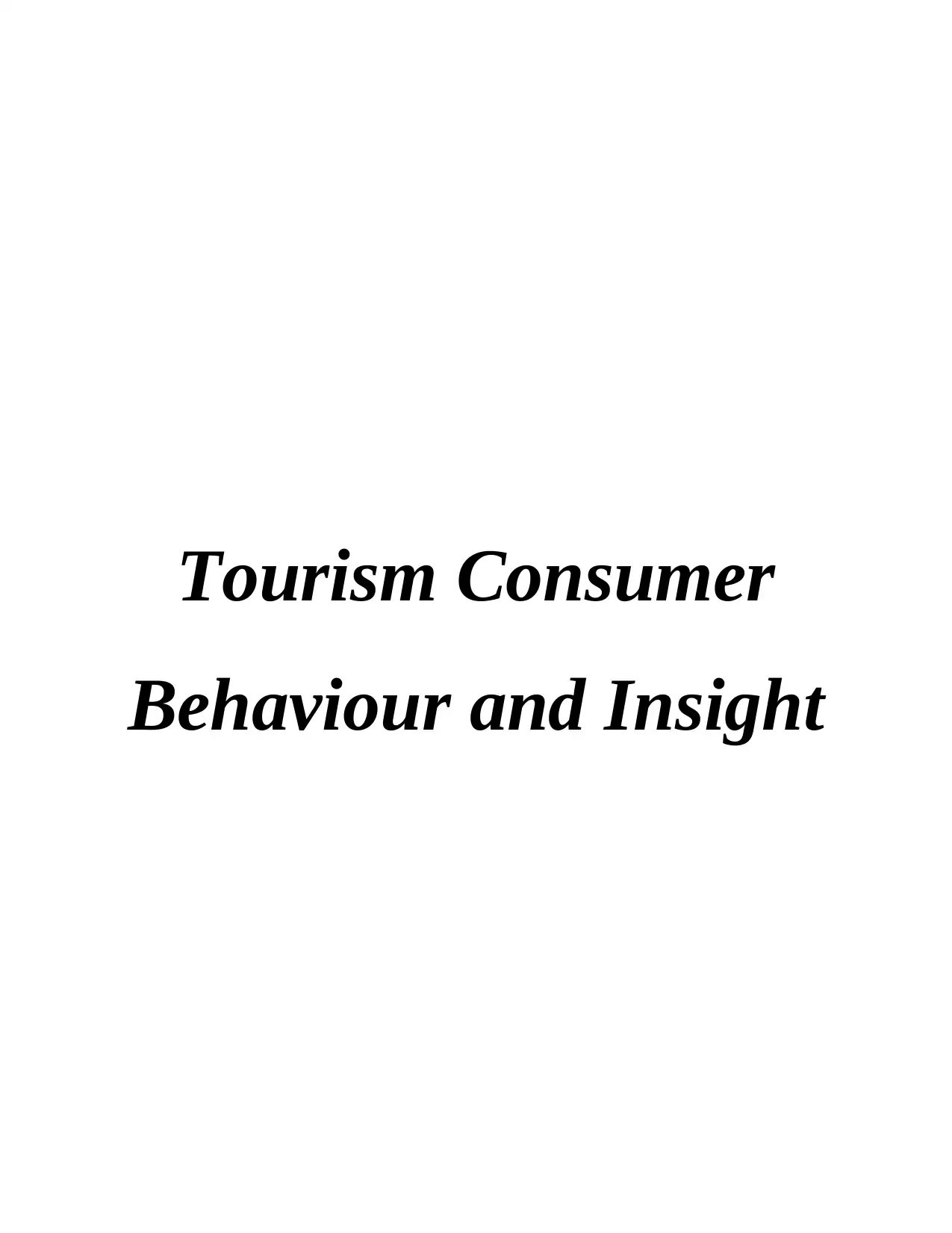
Tourism Consumer
Behaviour and Insight
Behaviour and Insight
Paraphrase This Document
Need a fresh take? Get an instant paraphrase of this document with our AI Paraphraser

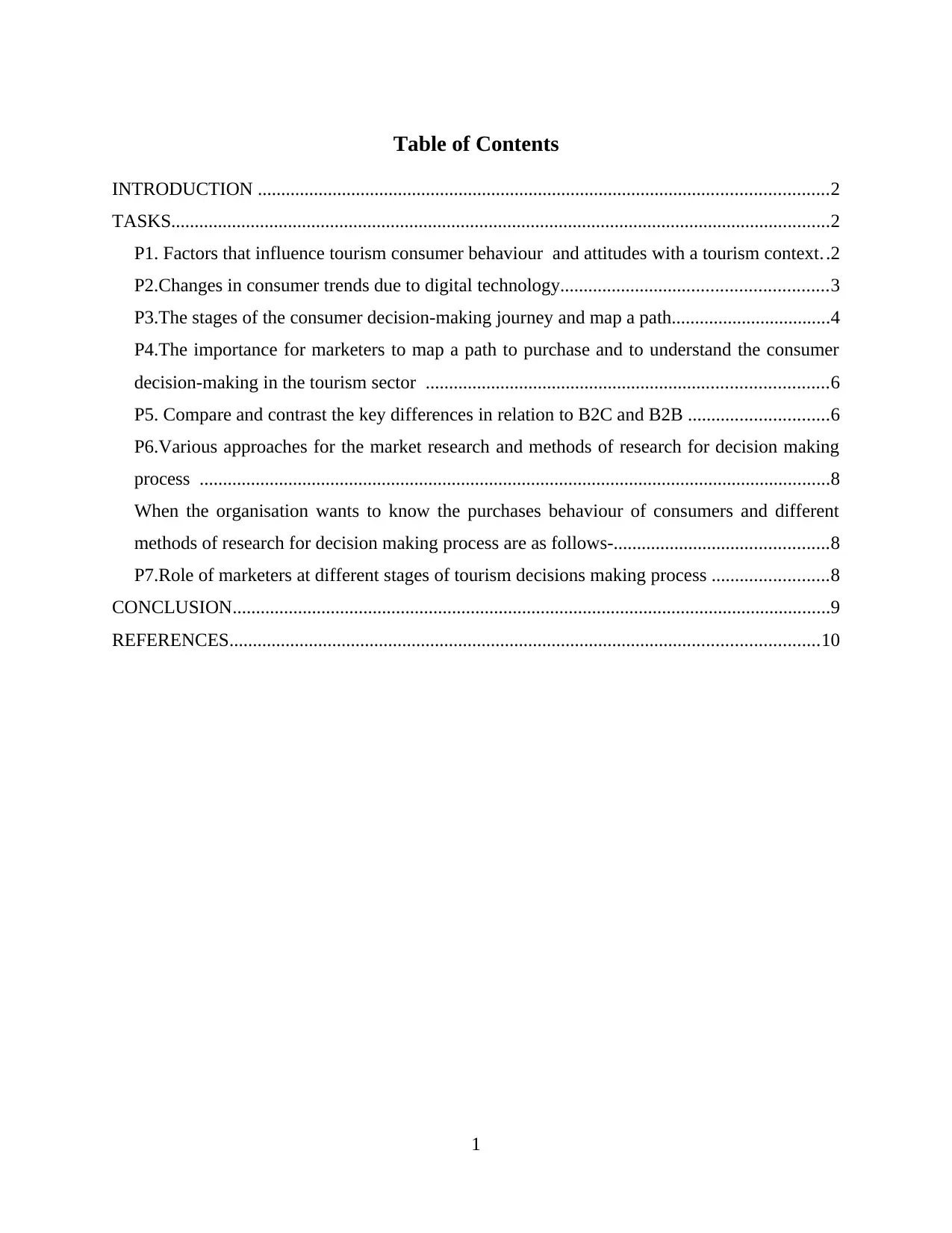
Table of Contents
INTRODUCTION ..........................................................................................................................2
TASKS.............................................................................................................................................2
P1. Factors that influence tourism consumer behaviour and attitudes with a tourism context. .2
P2.Changes in consumer trends due to digital technology.........................................................3
P3.The stages of the consumer decision-making journey and map a path..................................4
P4.The importance for marketers to map a path to purchase and to understand the consumer
decision-making in the tourism sector ......................................................................................6
P5. Compare and contrast the key differences in relation to B2C and B2B ..............................6
P6.Various approaches for the market research and methods of research for decision making
process .......................................................................................................................................8
When the organisation wants to know the purchases behaviour of consumers and different
methods of research for decision making process are as follows-..............................................8
P7.Role of marketers at different stages of tourism decisions making process .........................8
CONCLUSION................................................................................................................................9
REFERENCES..............................................................................................................................10
1
INTRODUCTION ..........................................................................................................................2
TASKS.............................................................................................................................................2
P1. Factors that influence tourism consumer behaviour and attitudes with a tourism context. .2
P2.Changes in consumer trends due to digital technology.........................................................3
P3.The stages of the consumer decision-making journey and map a path..................................4
P4.The importance for marketers to map a path to purchase and to understand the consumer
decision-making in the tourism sector ......................................................................................6
P5. Compare and contrast the key differences in relation to B2C and B2B ..............................6
P6.Various approaches for the market research and methods of research for decision making
process .......................................................................................................................................8
When the organisation wants to know the purchases behaviour of consumers and different
methods of research for decision making process are as follows-..............................................8
P7.Role of marketers at different stages of tourism decisions making process .........................8
CONCLUSION................................................................................................................................9
REFERENCES..............................................................................................................................10
1
⊘ This is a preview!⊘
Do you want full access?
Subscribe today to unlock all pages.

Trusted by 1+ million students worldwide
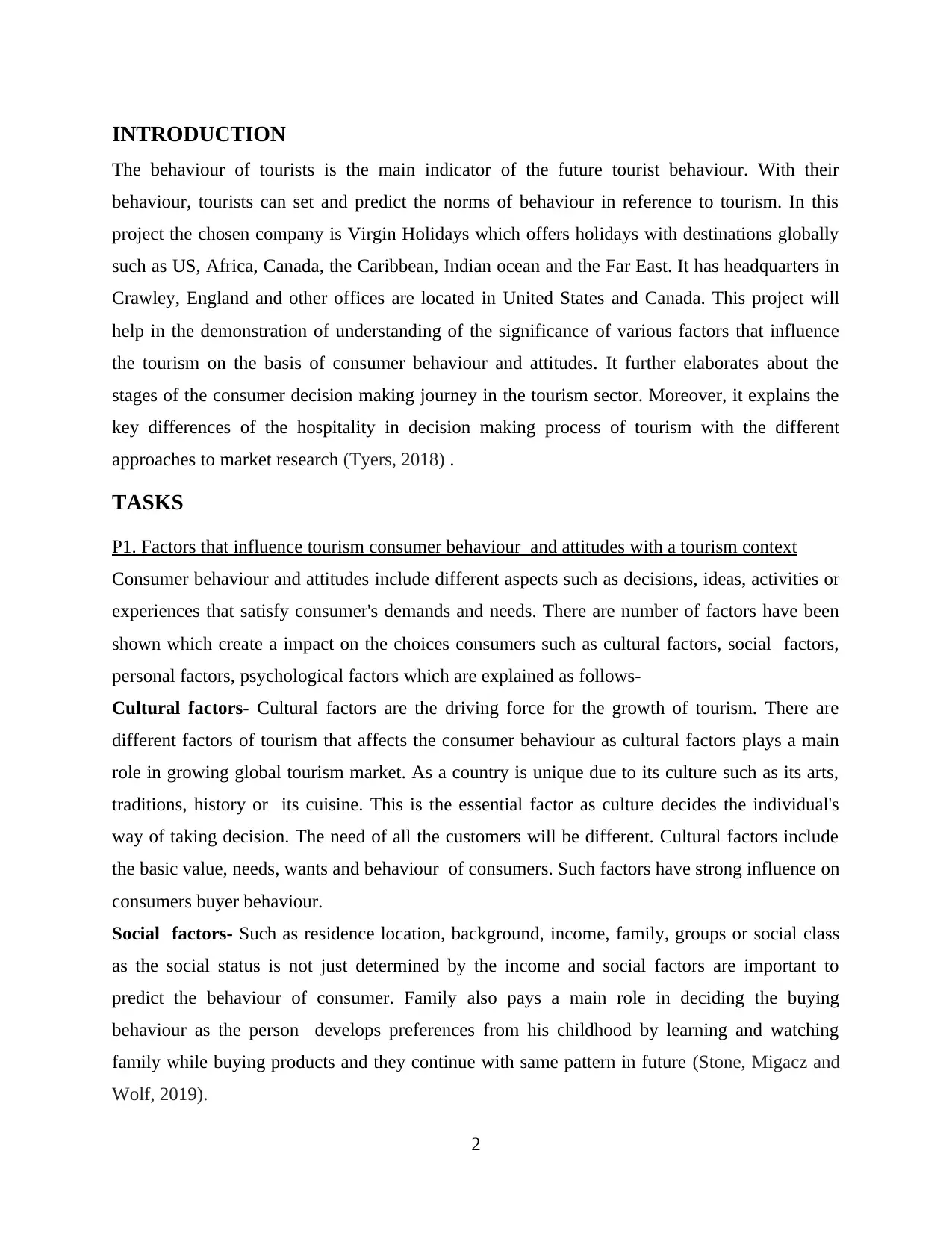
INTRODUCTION
The behaviour of tourists is the main indicator of the future tourist behaviour. With their
behaviour, tourists can set and predict the norms of behaviour in reference to tourism. In this
project the chosen company is Virgin Holidays which offers holidays with destinations globally
such as US, Africa, Canada, the Caribbean, Indian ocean and the Far East. It has headquarters in
Crawley, England and other offices are located in United States and Canada. This project will
help in the demonstration of understanding of the significance of various factors that influence
the tourism on the basis of consumer behaviour and attitudes. It further elaborates about the
stages of the consumer decision making journey in the tourism sector. Moreover, it explains the
key differences of the hospitality in decision making process of tourism with the different
approaches to market research (Tyers, 2018) .
TASKS
P1. Factors that influence tourism consumer behaviour and attitudes with a tourism context
Consumer behaviour and attitudes include different aspects such as decisions, ideas, activities or
experiences that satisfy consumer's demands and needs. There are number of factors have been
shown which create a impact on the choices consumers such as cultural factors, social factors,
personal factors, psychological factors which are explained as follows-
Cultural factors- Cultural factors are the driving force for the growth of tourism. There are
different factors of tourism that affects the consumer behaviour as cultural factors plays a main
role in growing global tourism market. As a country is unique due to its culture such as its arts,
traditions, history or its cuisine. This is the essential factor as culture decides the individual's
way of taking decision. The need of all the customers will be different. Cultural factors include
the basic value, needs, wants and behaviour of consumers. Such factors have strong influence on
consumers buyer behaviour.
Social factors- Such as residence location, background, income, family, groups or social class
as the social status is not just determined by the income and social factors are important to
predict the behaviour of consumer. Family also pays a main role in deciding the buying
behaviour as the person develops preferences from his childhood by learning and watching
family while buying products and they continue with same pattern in future (Stone, Migacz and
Wolf, 2019).
2
The behaviour of tourists is the main indicator of the future tourist behaviour. With their
behaviour, tourists can set and predict the norms of behaviour in reference to tourism. In this
project the chosen company is Virgin Holidays which offers holidays with destinations globally
such as US, Africa, Canada, the Caribbean, Indian ocean and the Far East. It has headquarters in
Crawley, England and other offices are located in United States and Canada. This project will
help in the demonstration of understanding of the significance of various factors that influence
the tourism on the basis of consumer behaviour and attitudes. It further elaborates about the
stages of the consumer decision making journey in the tourism sector. Moreover, it explains the
key differences of the hospitality in decision making process of tourism with the different
approaches to market research (Tyers, 2018) .
TASKS
P1. Factors that influence tourism consumer behaviour and attitudes with a tourism context
Consumer behaviour and attitudes include different aspects such as decisions, ideas, activities or
experiences that satisfy consumer's demands and needs. There are number of factors have been
shown which create a impact on the choices consumers such as cultural factors, social factors,
personal factors, psychological factors which are explained as follows-
Cultural factors- Cultural factors are the driving force for the growth of tourism. There are
different factors of tourism that affects the consumer behaviour as cultural factors plays a main
role in growing global tourism market. As a country is unique due to its culture such as its arts,
traditions, history or its cuisine. This is the essential factor as culture decides the individual's
way of taking decision. The need of all the customers will be different. Cultural factors include
the basic value, needs, wants and behaviour of consumers. Such factors have strong influence on
consumers buyer behaviour.
Social factors- Such as residence location, background, income, family, groups or social class
as the social status is not just determined by the income and social factors are important to
predict the behaviour of consumer. Family also pays a main role in deciding the buying
behaviour as the person develops preferences from his childhood by learning and watching
family while buying products and they continue with same pattern in future (Stone, Migacz and
Wolf, 2019).
2
Paraphrase This Document
Need a fresh take? Get an instant paraphrase of this document with our AI Paraphraser
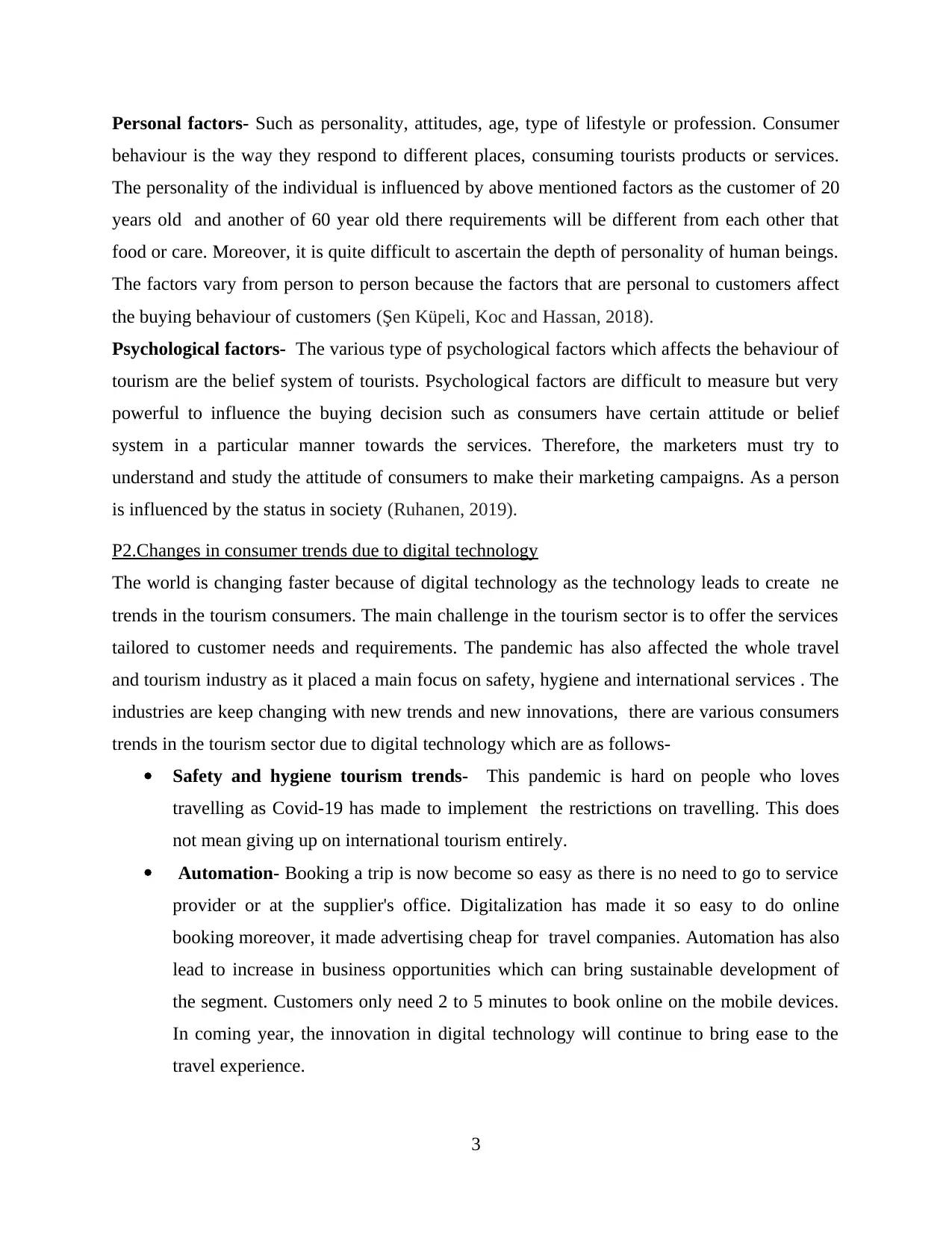
Personal factors- Such as personality, attitudes, age, type of lifestyle or profession. Consumer
behaviour is the way they respond to different places, consuming tourists products or services.
The personality of the individual is influenced by above mentioned factors as the customer of 20
years old and another of 60 year old there requirements will be different from each other that
food or care. Moreover, it is quite difficult to ascertain the depth of personality of human beings.
The factors vary from person to person because the factors that are personal to customers affect
the buying behaviour of customers (Şen Küpeli, Koc and Hassan, 2018).
Psychological factors- The various type of psychological factors which affects the behaviour of
tourism are the belief system of tourists. Psychological factors are difficult to measure but very
powerful to influence the buying decision such as consumers have certain attitude or belief
system in a particular manner towards the services. Therefore, the marketers must try to
understand and study the attitude of consumers to make their marketing campaigns. As a person
is influenced by the status in society (Ruhanen, 2019).
P2.Changes in consumer trends due to digital technology
The world is changing faster because of digital technology as the technology leads to create ne
trends in the tourism consumers. The main challenge in the tourism sector is to offer the services
tailored to customer needs and requirements. The pandemic has also affected the whole travel
and tourism industry as it placed a main focus on safety, hygiene and international services . The
industries are keep changing with new trends and new innovations, there are various consumers
trends in the tourism sector due to digital technology which are as follows-
Safety and hygiene tourism trends- This pandemic is hard on people who loves
travelling as Covid-19 has made to implement the restrictions on travelling. This does
not mean giving up on international tourism entirely.
Automation- Booking a trip is now become so easy as there is no need to go to service
provider or at the supplier's office. Digitalization has made it so easy to do online
booking moreover, it made advertising cheap for travel companies. Automation has also
lead to increase in business opportunities which can bring sustainable development of
the segment. Customers only need 2 to 5 minutes to book online on the mobile devices.
In coming year, the innovation in digital technology will continue to bring ease to the
travel experience.
3
behaviour is the way they respond to different places, consuming tourists products or services.
The personality of the individual is influenced by above mentioned factors as the customer of 20
years old and another of 60 year old there requirements will be different from each other that
food or care. Moreover, it is quite difficult to ascertain the depth of personality of human beings.
The factors vary from person to person because the factors that are personal to customers affect
the buying behaviour of customers (Şen Küpeli, Koc and Hassan, 2018).
Psychological factors- The various type of psychological factors which affects the behaviour of
tourism are the belief system of tourists. Psychological factors are difficult to measure but very
powerful to influence the buying decision such as consumers have certain attitude or belief
system in a particular manner towards the services. Therefore, the marketers must try to
understand and study the attitude of consumers to make their marketing campaigns. As a person
is influenced by the status in society (Ruhanen, 2019).
P2.Changes in consumer trends due to digital technology
The world is changing faster because of digital technology as the technology leads to create ne
trends in the tourism consumers. The main challenge in the tourism sector is to offer the services
tailored to customer needs and requirements. The pandemic has also affected the whole travel
and tourism industry as it placed a main focus on safety, hygiene and international services . The
industries are keep changing with new trends and new innovations, there are various consumers
trends in the tourism sector due to digital technology which are as follows-
Safety and hygiene tourism trends- This pandemic is hard on people who loves
travelling as Covid-19 has made to implement the restrictions on travelling. This does
not mean giving up on international tourism entirely.
Automation- Booking a trip is now become so easy as there is no need to go to service
provider or at the supplier's office. Digitalization has made it so easy to do online
booking moreover, it made advertising cheap for travel companies. Automation has also
lead to increase in business opportunities which can bring sustainable development of
the segment. Customers only need 2 to 5 minutes to book online on the mobile devices.
In coming year, the innovation in digital technology will continue to bring ease to the
travel experience.
3
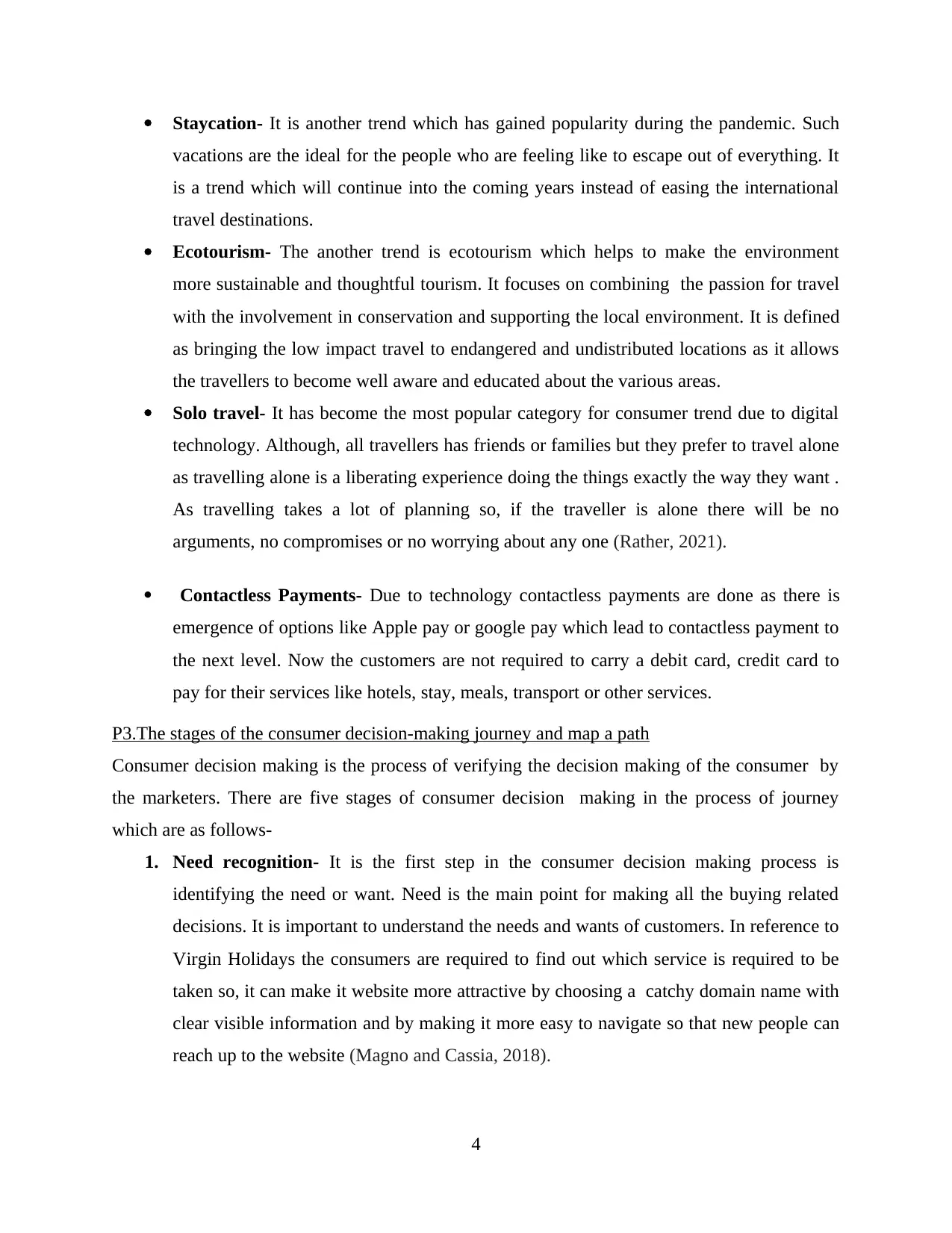
Staycation- It is another trend which has gained popularity during the pandemic. Such
vacations are the ideal for the people who are feeling like to escape out of everything. It
is a trend which will continue into the coming years instead of easing the international
travel destinations.
Ecotourism- The another trend is ecotourism which helps to make the environment
more sustainable and thoughtful tourism. It focuses on combining the passion for travel
with the involvement in conservation and supporting the local environment. It is defined
as bringing the low impact travel to endangered and undistributed locations as it allows
the travellers to become well aware and educated about the various areas.
Solo travel- It has become the most popular category for consumer trend due to digital
technology. Although, all travellers has friends or families but they prefer to travel alone
as travelling alone is a liberating experience doing the things exactly the way they want .
As travelling takes a lot of planning so, if the traveller is alone there will be no
arguments, no compromises or no worrying about any one (Rather, 2021).
Contactless Payments- Due to technology contactless payments are done as there is
emergence of options like Apple pay or google pay which lead to contactless payment to
the next level. Now the customers are not required to carry a debit card, credit card to
pay for their services like hotels, stay, meals, transport or other services.
P3.The stages of the consumer decision-making journey and map a path
Consumer decision making is the process of verifying the decision making of the consumer by
the marketers. There are five stages of consumer decision making in the process of journey
which are as follows-
1. Need recognition- It is the first step in the consumer decision making process is
identifying the need or want. Need is the main point for making all the buying related
decisions. It is important to understand the needs and wants of customers. In reference to
Virgin Holidays the consumers are required to find out which service is required to be
taken so, it can make it website more attractive by choosing a catchy domain name with
clear visible information and by making it more easy to navigate so that new people can
reach up to the website (Magno and Cassia, 2018).
4
vacations are the ideal for the people who are feeling like to escape out of everything. It
is a trend which will continue into the coming years instead of easing the international
travel destinations.
Ecotourism- The another trend is ecotourism which helps to make the environment
more sustainable and thoughtful tourism. It focuses on combining the passion for travel
with the involvement in conservation and supporting the local environment. It is defined
as bringing the low impact travel to endangered and undistributed locations as it allows
the travellers to become well aware and educated about the various areas.
Solo travel- It has become the most popular category for consumer trend due to digital
technology. Although, all travellers has friends or families but they prefer to travel alone
as travelling alone is a liberating experience doing the things exactly the way they want .
As travelling takes a lot of planning so, if the traveller is alone there will be no
arguments, no compromises or no worrying about any one (Rather, 2021).
Contactless Payments- Due to technology contactless payments are done as there is
emergence of options like Apple pay or google pay which lead to contactless payment to
the next level. Now the customers are not required to carry a debit card, credit card to
pay for their services like hotels, stay, meals, transport or other services.
P3.The stages of the consumer decision-making journey and map a path
Consumer decision making is the process of verifying the decision making of the consumer by
the marketers. There are five stages of consumer decision making in the process of journey
which are as follows-
1. Need recognition- It is the first step in the consumer decision making process is
identifying the need or want. Need is the main point for making all the buying related
decisions. It is important to understand the needs and wants of customers. In reference to
Virgin Holidays the consumers are required to find out which service is required to be
taken so, it can make it website more attractive by choosing a catchy domain name with
clear visible information and by making it more easy to navigate so that new people can
reach up to the website (Magno and Cassia, 2018).
4
⊘ This is a preview!⊘
Do you want full access?
Subscribe today to unlock all pages.

Trusted by 1+ million students worldwide
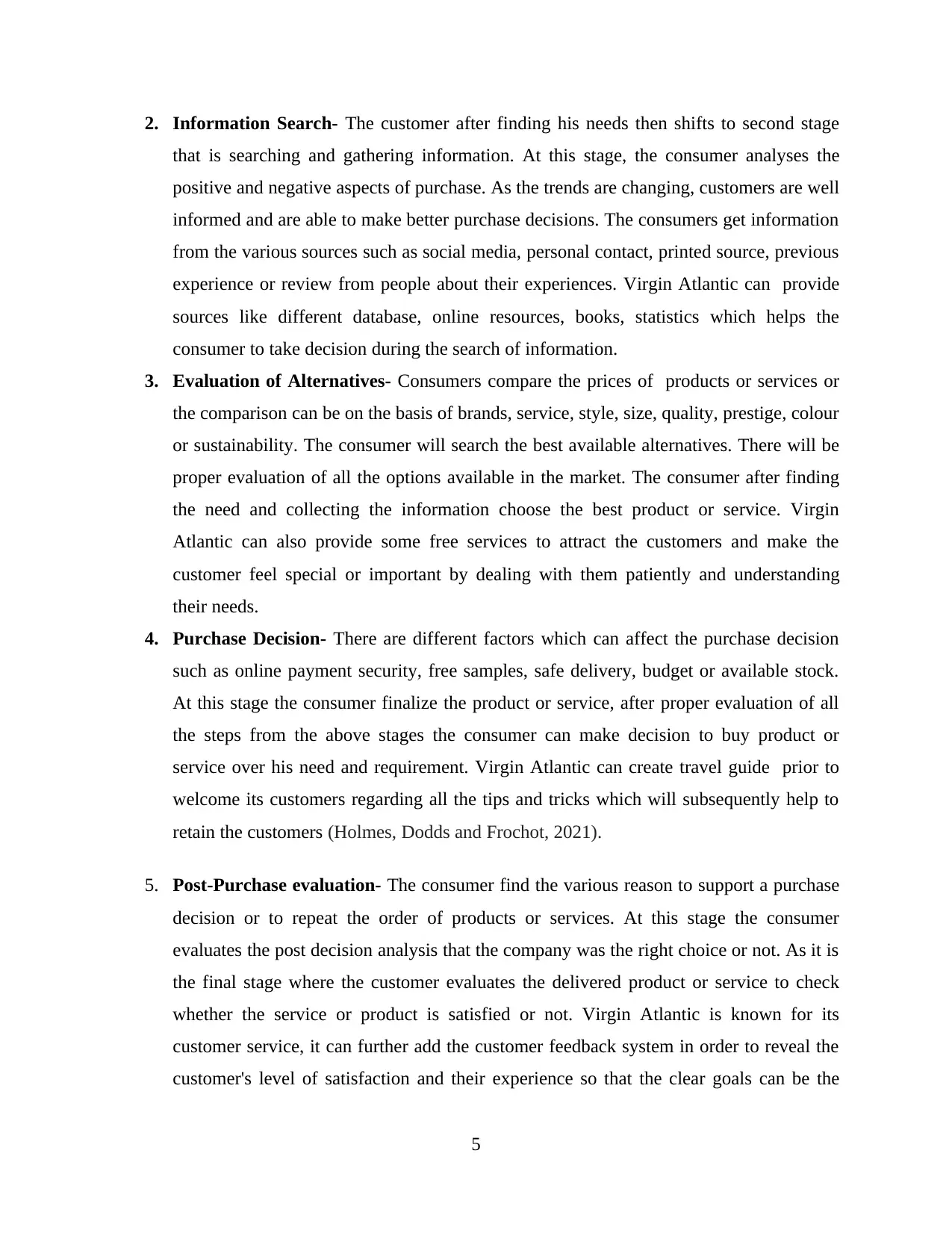
2. Information Search- The customer after finding his needs then shifts to second stage
that is searching and gathering information. At this stage, the consumer analyses the
positive and negative aspects of purchase. As the trends are changing, customers are well
informed and are able to make better purchase decisions. The consumers get information
from the various sources such as social media, personal contact, printed source, previous
experience or review from people about their experiences. Virgin Atlantic can provide
sources like different database, online resources, books, statistics which helps the
consumer to take decision during the search of information.
3. Evaluation of Alternatives- Consumers compare the prices of products or services or
the comparison can be on the basis of brands, service, style, size, quality, prestige, colour
or sustainability. The consumer will search the best available alternatives. There will be
proper evaluation of all the options available in the market. The consumer after finding
the need and collecting the information choose the best product or service. Virgin
Atlantic can also provide some free services to attract the customers and make the
customer feel special or important by dealing with them patiently and understanding
their needs.
4. Purchase Decision- There are different factors which can affect the purchase decision
such as online payment security, free samples, safe delivery, budget or available stock.
At this stage the consumer finalize the product or service, after proper evaluation of all
the steps from the above stages the consumer can make decision to buy product or
service over his need and requirement. Virgin Atlantic can create travel guide prior to
welcome its customers regarding all the tips and tricks which will subsequently help to
retain the customers (Holmes, Dodds and Frochot, 2021).
5. Post-Purchase evaluation- The consumer find the various reason to support a purchase
decision or to repeat the order of products or services. At this stage the consumer
evaluates the post decision analysis that the company was the right choice or not. As it is
the final stage where the customer evaluates the delivered product or service to check
whether the service or product is satisfied or not. Virgin Atlantic is known for its
customer service, it can further add the customer feedback system in order to reveal the
customer's level of satisfaction and their experience so that the clear goals can be the
5
that is searching and gathering information. At this stage, the consumer analyses the
positive and negative aspects of purchase. As the trends are changing, customers are well
informed and are able to make better purchase decisions. The consumers get information
from the various sources such as social media, personal contact, printed source, previous
experience or review from people about their experiences. Virgin Atlantic can provide
sources like different database, online resources, books, statistics which helps the
consumer to take decision during the search of information.
3. Evaluation of Alternatives- Consumers compare the prices of products or services or
the comparison can be on the basis of brands, service, style, size, quality, prestige, colour
or sustainability. The consumer will search the best available alternatives. There will be
proper evaluation of all the options available in the market. The consumer after finding
the need and collecting the information choose the best product or service. Virgin
Atlantic can also provide some free services to attract the customers and make the
customer feel special or important by dealing with them patiently and understanding
their needs.
4. Purchase Decision- There are different factors which can affect the purchase decision
such as online payment security, free samples, safe delivery, budget or available stock.
At this stage the consumer finalize the product or service, after proper evaluation of all
the steps from the above stages the consumer can make decision to buy product or
service over his need and requirement. Virgin Atlantic can create travel guide prior to
welcome its customers regarding all the tips and tricks which will subsequently help to
retain the customers (Holmes, Dodds and Frochot, 2021).
5. Post-Purchase evaluation- The consumer find the various reason to support a purchase
decision or to repeat the order of products or services. At this stage the consumer
evaluates the post decision analysis that the company was the right choice or not. As it is
the final stage where the customer evaluates the delivered product or service to check
whether the service or product is satisfied or not. Virgin Atlantic is known for its
customer service, it can further add the customer feedback system in order to reveal the
customer's level of satisfaction and their experience so that the clear goals can be the
5
Paraphrase This Document
Need a fresh take? Get an instant paraphrase of this document with our AI Paraphraser
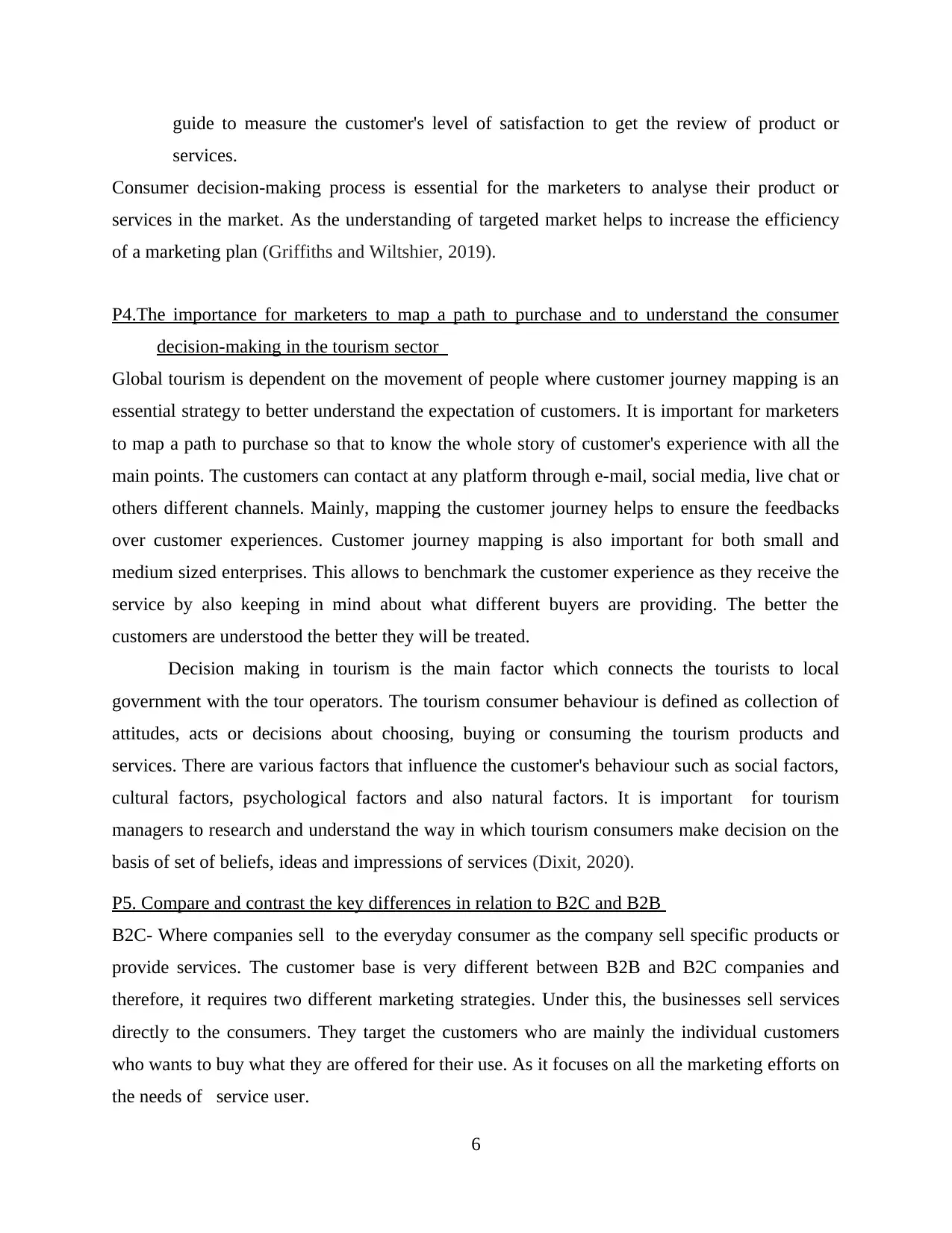
guide to measure the customer's level of satisfaction to get the review of product or
services.
Consumer decision-making process is essential for the marketers to analyse their product or
services in the market. As the understanding of targeted market helps to increase the efficiency
of a marketing plan (Griffiths and Wiltshier, 2019).
P4.The importance for marketers to map a path to purchase and to understand the consumer
decision-making in the tourism sector
Global tourism is dependent on the movement of people where customer journey mapping is an
essential strategy to better understand the expectation of customers. It is important for marketers
to map a path to purchase so that to know the whole story of customer's experience with all the
main points. The customers can contact at any platform through e-mail, social media, live chat or
others different channels. Mainly, mapping the customer journey helps to ensure the feedbacks
over customer experiences. Customer journey mapping is also important for both small and
medium sized enterprises. This allows to benchmark the customer experience as they receive the
service by also keeping in mind about what different buyers are providing. The better the
customers are understood the better they will be treated.
Decision making in tourism is the main factor which connects the tourists to local
government with the tour operators. The tourism consumer behaviour is defined as collection of
attitudes, acts or decisions about choosing, buying or consuming the tourism products and
services. There are various factors that influence the customer's behaviour such as social factors,
cultural factors, psychological factors and also natural factors. It is important for tourism
managers to research and understand the way in which tourism consumers make decision on the
basis of set of beliefs, ideas and impressions of services (Dixit, 2020).
P5. Compare and contrast the key differences in relation to B2C and B2B
B2C- Where companies sell to the everyday consumer as the company sell specific products or
provide services. The customer base is very different between B2B and B2C companies and
therefore, it requires two different marketing strategies. Under this, the businesses sell services
directly to the consumers. They target the customers who are mainly the individual customers
who wants to buy what they are offered for their use. As it focuses on all the marketing efforts on
the needs of service user.
6
services.
Consumer decision-making process is essential for the marketers to analyse their product or
services in the market. As the understanding of targeted market helps to increase the efficiency
of a marketing plan (Griffiths and Wiltshier, 2019).
P4.The importance for marketers to map a path to purchase and to understand the consumer
decision-making in the tourism sector
Global tourism is dependent on the movement of people where customer journey mapping is an
essential strategy to better understand the expectation of customers. It is important for marketers
to map a path to purchase so that to know the whole story of customer's experience with all the
main points. The customers can contact at any platform through e-mail, social media, live chat or
others different channels. Mainly, mapping the customer journey helps to ensure the feedbacks
over customer experiences. Customer journey mapping is also important for both small and
medium sized enterprises. This allows to benchmark the customer experience as they receive the
service by also keeping in mind about what different buyers are providing. The better the
customers are understood the better they will be treated.
Decision making in tourism is the main factor which connects the tourists to local
government with the tour operators. The tourism consumer behaviour is defined as collection of
attitudes, acts or decisions about choosing, buying or consuming the tourism products and
services. There are various factors that influence the customer's behaviour such as social factors,
cultural factors, psychological factors and also natural factors. It is important for tourism
managers to research and understand the way in which tourism consumers make decision on the
basis of set of beliefs, ideas and impressions of services (Dixit, 2020).
P5. Compare and contrast the key differences in relation to B2C and B2B
B2C- Where companies sell to the everyday consumer as the company sell specific products or
provide services. The customer base is very different between B2B and B2C companies and
therefore, it requires two different marketing strategies. Under this, the businesses sell services
directly to the consumers. They target the customers who are mainly the individual customers
who wants to buy what they are offered for their use. As it focuses on all the marketing efforts on
the needs of service user.
6
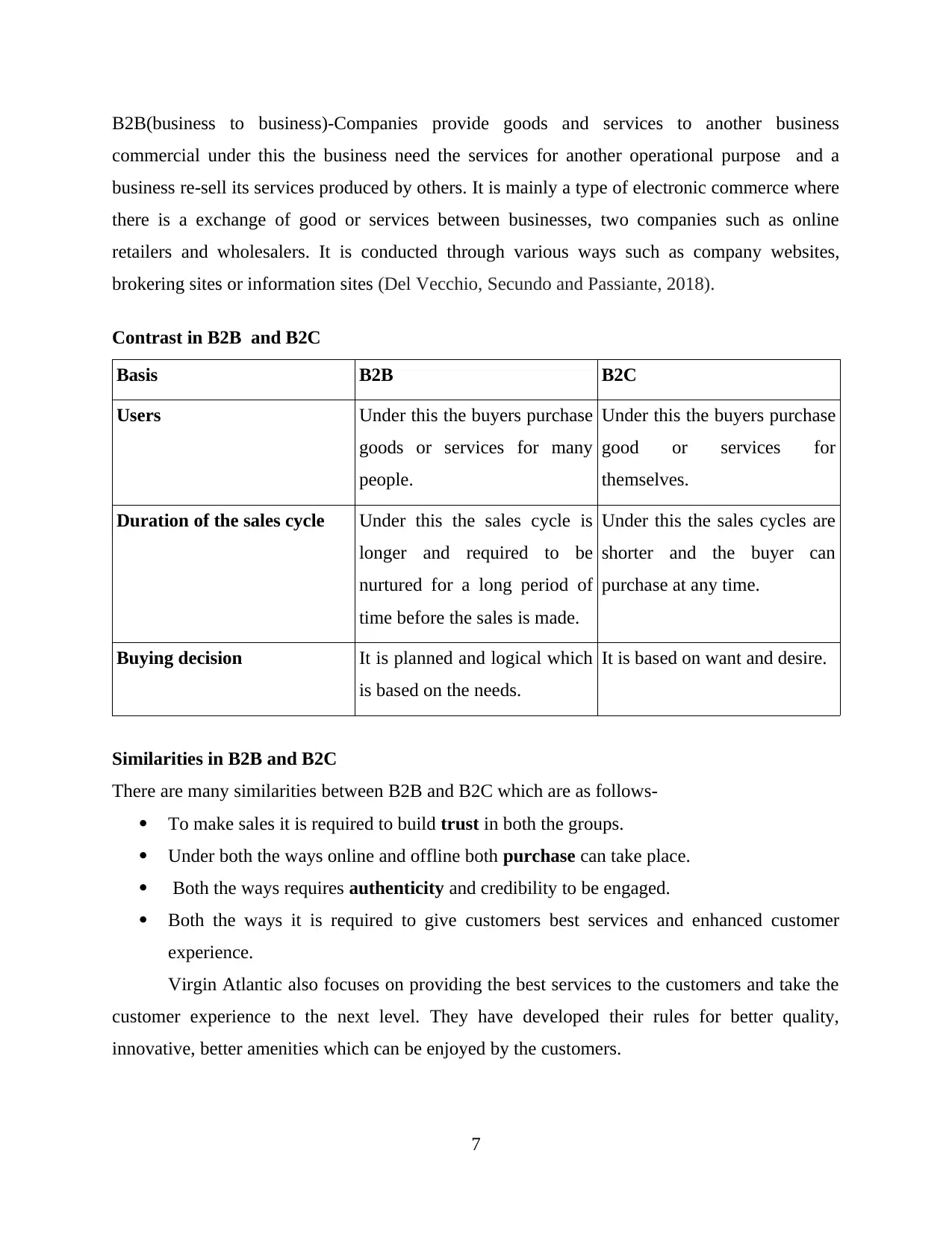
B2B(business to business)-Companies provide goods and services to another business
commercial under this the business need the services for another operational purpose and a
business re-sell its services produced by others. It is mainly a type of electronic commerce where
there is a exchange of good or services between businesses, two companies such as online
retailers and wholesalers. It is conducted through various ways such as company websites,
brokering sites or information sites (Del Vecchio, Secundo and Passiante, 2018).
Contrast in B2B and B2C
Basis B2B B2C
Users Under this the buyers purchase
goods or services for many
people.
Under this the buyers purchase
good or services for
themselves.
Duration of the sales cycle Under this the sales cycle is
longer and required to be
nurtured for a long period of
time before the sales is made.
Under this the sales cycles are
shorter and the buyer can
purchase at any time.
Buying decision It is planned and logical which
is based on the needs.
It is based on want and desire.
Similarities in B2B and B2C
There are many similarities between B2B and B2C which are as follows-
To make sales it is required to build trust in both the groups.
Under both the ways online and offline both purchase can take place.
Both the ways requires authenticity and credibility to be engaged.
Both the ways it is required to give customers best services and enhanced customer
experience.
Virgin Atlantic also focuses on providing the best services to the customers and take the
customer experience to the next level. They have developed their rules for better quality,
innovative, better amenities which can be enjoyed by the customers.
7
commercial under this the business need the services for another operational purpose and a
business re-sell its services produced by others. It is mainly a type of electronic commerce where
there is a exchange of good or services between businesses, two companies such as online
retailers and wholesalers. It is conducted through various ways such as company websites,
brokering sites or information sites (Del Vecchio, Secundo and Passiante, 2018).
Contrast in B2B and B2C
Basis B2B B2C
Users Under this the buyers purchase
goods or services for many
people.
Under this the buyers purchase
good or services for
themselves.
Duration of the sales cycle Under this the sales cycle is
longer and required to be
nurtured for a long period of
time before the sales is made.
Under this the sales cycles are
shorter and the buyer can
purchase at any time.
Buying decision It is planned and logical which
is based on the needs.
It is based on want and desire.
Similarities in B2B and B2C
There are many similarities between B2B and B2C which are as follows-
To make sales it is required to build trust in both the groups.
Under both the ways online and offline both purchase can take place.
Both the ways requires authenticity and credibility to be engaged.
Both the ways it is required to give customers best services and enhanced customer
experience.
Virgin Atlantic also focuses on providing the best services to the customers and take the
customer experience to the next level. They have developed their rules for better quality,
innovative, better amenities which can be enjoyed by the customers.
7
⊘ This is a preview!⊘
Do you want full access?
Subscribe today to unlock all pages.

Trusted by 1+ million students worldwide
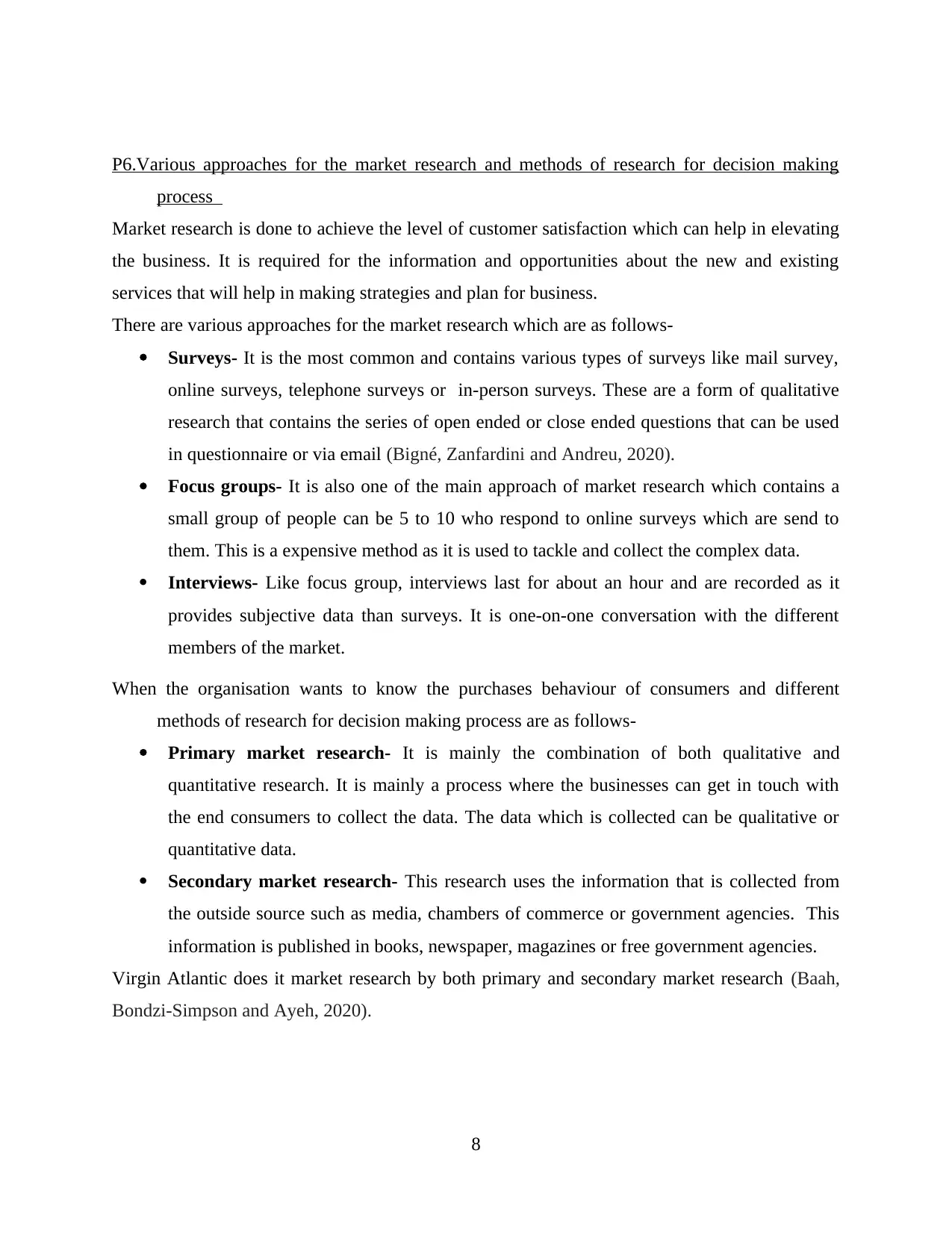
P6.Various approaches for the market research and methods of research for decision making
process
Market research is done to achieve the level of customer satisfaction which can help in elevating
the business. It is required for the information and opportunities about the new and existing
services that will help in making strategies and plan for business.
There are various approaches for the market research which are as follows-
Surveys- It is the most common and contains various types of surveys like mail survey,
online surveys, telephone surveys or in-person surveys. These are a form of qualitative
research that contains the series of open ended or close ended questions that can be used
in questionnaire or via email (Bigné, Zanfardini and Andreu, 2020).
Focus groups- It is also one of the main approach of market research which contains a
small group of people can be 5 to 10 who respond to online surveys which are send to
them. This is a expensive method as it is used to tackle and collect the complex data.
Interviews- Like focus group, interviews last for about an hour and are recorded as it
provides subjective data than surveys. It is one-on-one conversation with the different
members of the market.
When the organisation wants to know the purchases behaviour of consumers and different
methods of research for decision making process are as follows-
Primary market research- It is mainly the combination of both qualitative and
quantitative research. It is mainly a process where the businesses can get in touch with
the end consumers to collect the data. The data which is collected can be qualitative or
quantitative data.
Secondary market research- This research uses the information that is collected from
the outside source such as media, chambers of commerce or government agencies. This
information is published in books, newspaper, magazines or free government agencies.
Virgin Atlantic does it market research by both primary and secondary market research (Baah,
Bondzi-Simpson and Ayeh, 2020).
8
process
Market research is done to achieve the level of customer satisfaction which can help in elevating
the business. It is required for the information and opportunities about the new and existing
services that will help in making strategies and plan for business.
There are various approaches for the market research which are as follows-
Surveys- It is the most common and contains various types of surveys like mail survey,
online surveys, telephone surveys or in-person surveys. These are a form of qualitative
research that contains the series of open ended or close ended questions that can be used
in questionnaire or via email (Bigné, Zanfardini and Andreu, 2020).
Focus groups- It is also one of the main approach of market research which contains a
small group of people can be 5 to 10 who respond to online surveys which are send to
them. This is a expensive method as it is used to tackle and collect the complex data.
Interviews- Like focus group, interviews last for about an hour and are recorded as it
provides subjective data than surveys. It is one-on-one conversation with the different
members of the market.
When the organisation wants to know the purchases behaviour of consumers and different
methods of research for decision making process are as follows-
Primary market research- It is mainly the combination of both qualitative and
quantitative research. It is mainly a process where the businesses can get in touch with
the end consumers to collect the data. The data which is collected can be qualitative or
quantitative data.
Secondary market research- This research uses the information that is collected from
the outside source such as media, chambers of commerce or government agencies. This
information is published in books, newspaper, magazines or free government agencies.
Virgin Atlantic does it market research by both primary and secondary market research (Baah,
Bondzi-Simpson and Ayeh, 2020).
8
Paraphrase This Document
Need a fresh take? Get an instant paraphrase of this document with our AI Paraphraser
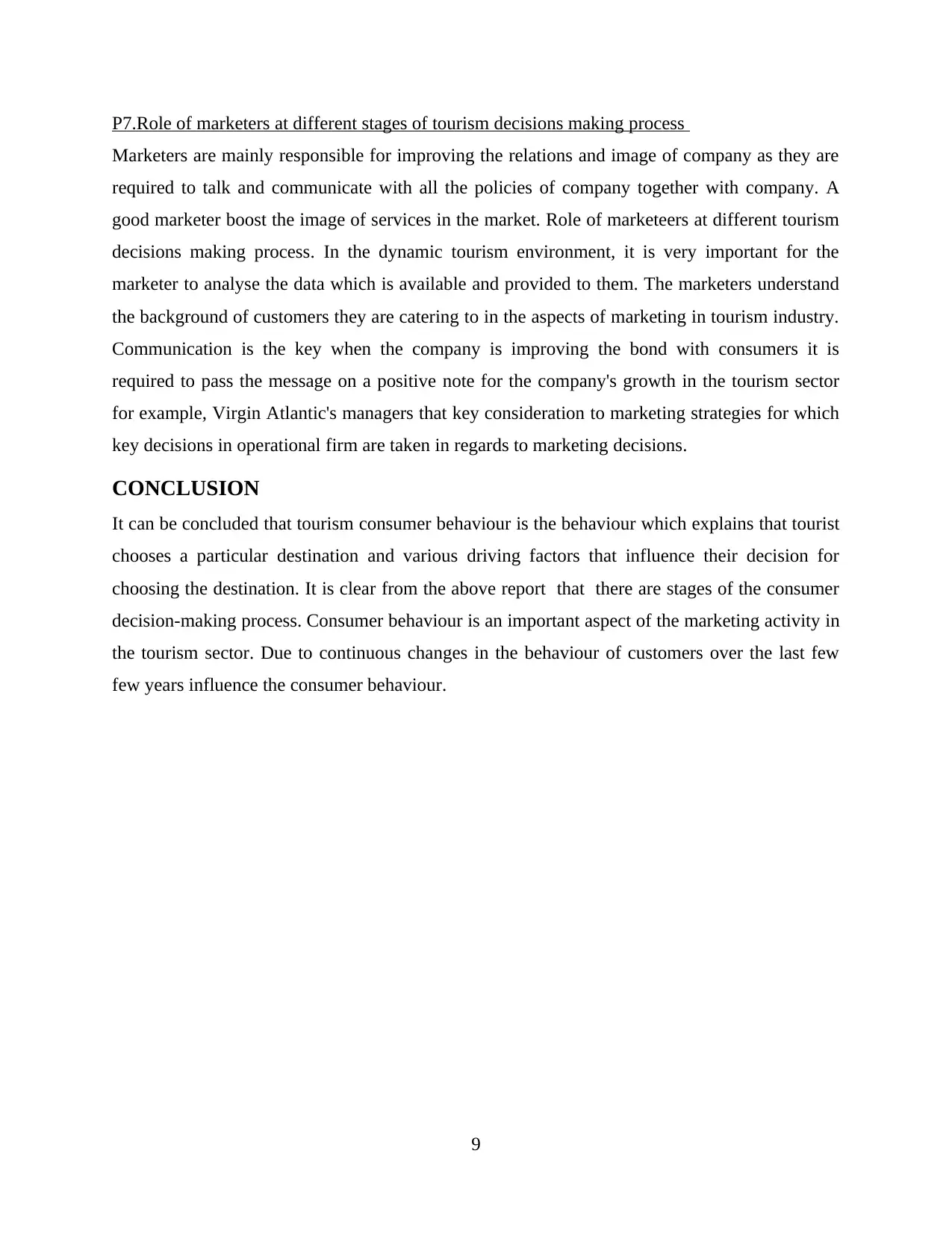
P7.Role of marketers at different stages of tourism decisions making process
Marketers are mainly responsible for improving the relations and image of company as they are
required to talk and communicate with all the policies of company together with company. A
good marketer boost the image of services in the market. Role of marketeers at different tourism
decisions making process. In the dynamic tourism environment, it is very important for the
marketer to analyse the data which is available and provided to them. The marketers understand
the background of customers they are catering to in the aspects of marketing in tourism industry.
Communication is the key when the company is improving the bond with consumers it is
required to pass the message on a positive note for the company's growth in the tourism sector
for example, Virgin Atlantic's managers that key consideration to marketing strategies for which
key decisions in operational firm are taken in regards to marketing decisions.
CONCLUSION
It can be concluded that tourism consumer behaviour is the behaviour which explains that tourist
chooses a particular destination and various driving factors that influence their decision for
choosing the destination. It is clear from the above report that there are stages of the consumer
decision-making process. Consumer behaviour is an important aspect of the marketing activity in
the tourism sector. Due to continuous changes in the behaviour of customers over the last few
few years influence the consumer behaviour.
9
Marketers are mainly responsible for improving the relations and image of company as they are
required to talk and communicate with all the policies of company together with company. A
good marketer boost the image of services in the market. Role of marketeers at different tourism
decisions making process. In the dynamic tourism environment, it is very important for the
marketer to analyse the data which is available and provided to them. The marketers understand
the background of customers they are catering to in the aspects of marketing in tourism industry.
Communication is the key when the company is improving the bond with consumers it is
required to pass the message on a positive note for the company's growth in the tourism sector
for example, Virgin Atlantic's managers that key consideration to marketing strategies for which
key decisions in operational firm are taken in regards to marketing decisions.
CONCLUSION
It can be concluded that tourism consumer behaviour is the behaviour which explains that tourist
chooses a particular destination and various driving factors that influence their decision for
choosing the destination. It is clear from the above report that there are stages of the consumer
decision-making process. Consumer behaviour is an important aspect of the marketing activity in
the tourism sector. Due to continuous changes in the behaviour of customers over the last few
few years influence the consumer behaviour.
9
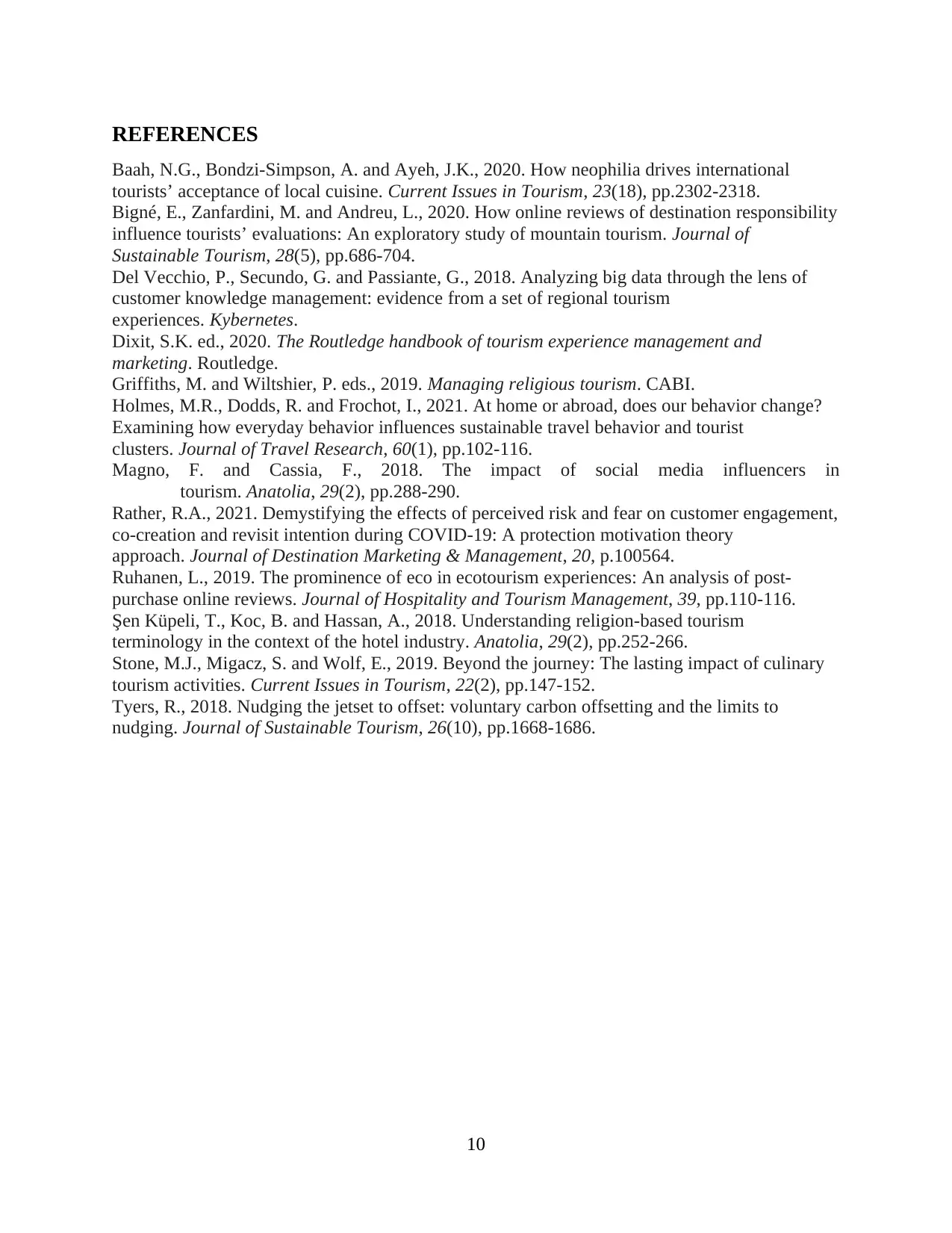
REFERENCES
Baah, N.G., Bondzi-Simpson, A. and Ayeh, J.K., 2020. How neophilia drives international
tourists’ acceptance of local cuisine. Current Issues in Tourism, 23(18), pp.2302-2318.
Bigné, E., Zanfardini, M. and Andreu, L., 2020. How online reviews of destination responsibility
influence tourists’ evaluations: An exploratory study of mountain tourism. Journal of
Sustainable Tourism, 28(5), pp.686-704.
Del Vecchio, P., Secundo, G. and Passiante, G., 2018. Analyzing big data through the lens of
customer knowledge management: evidence from a set of regional tourism
experiences. Kybernetes.
Dixit, S.K. ed., 2020. The Routledge handbook of tourism experience management and
marketing. Routledge.
Griffiths, M. and Wiltshier, P. eds., 2019. Managing religious tourism. CABI.
Holmes, M.R., Dodds, R. and Frochot, I., 2021. At home or abroad, does our behavior change?
Examining how everyday behavior influences sustainable travel behavior and tourist
clusters. Journal of Travel Research, 60(1), pp.102-116.
Magno, F. and Cassia, F., 2018. The impact of social media influencers in
tourism. Anatolia, 29(2), pp.288-290.
Rather, R.A., 2021. Demystifying the effects of perceived risk and fear on customer engagement,
co-creation and revisit intention during COVID-19: A protection motivation theory
approach. Journal of Destination Marketing & Management, 20, p.100564.
Ruhanen, L., 2019. The prominence of eco in ecotourism experiences: An analysis of post-
purchase online reviews. Journal of Hospitality and Tourism Management, 39, pp.110-116.
Şen Küpeli, T., Koc, B. and Hassan, A., 2018. Understanding religion-based tourism
terminology in the context of the hotel industry. Anatolia, 29(2), pp.252-266.
Stone, M.J., Migacz, S. and Wolf, E., 2019. Beyond the journey: The lasting impact of culinary
tourism activities. Current Issues in Tourism, 22(2), pp.147-152.
Tyers, R., 2018. Nudging the jetset to offset: voluntary carbon offsetting and the limits to
nudging. Journal of Sustainable Tourism, 26(10), pp.1668-1686.
10
Baah, N.G., Bondzi-Simpson, A. and Ayeh, J.K., 2020. How neophilia drives international
tourists’ acceptance of local cuisine. Current Issues in Tourism, 23(18), pp.2302-2318.
Bigné, E., Zanfardini, M. and Andreu, L., 2020. How online reviews of destination responsibility
influence tourists’ evaluations: An exploratory study of mountain tourism. Journal of
Sustainable Tourism, 28(5), pp.686-704.
Del Vecchio, P., Secundo, G. and Passiante, G., 2018. Analyzing big data through the lens of
customer knowledge management: evidence from a set of regional tourism
experiences. Kybernetes.
Dixit, S.K. ed., 2020. The Routledge handbook of tourism experience management and
marketing. Routledge.
Griffiths, M. and Wiltshier, P. eds., 2019. Managing religious tourism. CABI.
Holmes, M.R., Dodds, R. and Frochot, I., 2021. At home or abroad, does our behavior change?
Examining how everyday behavior influences sustainable travel behavior and tourist
clusters. Journal of Travel Research, 60(1), pp.102-116.
Magno, F. and Cassia, F., 2018. The impact of social media influencers in
tourism. Anatolia, 29(2), pp.288-290.
Rather, R.A., 2021. Demystifying the effects of perceived risk and fear on customer engagement,
co-creation and revisit intention during COVID-19: A protection motivation theory
approach. Journal of Destination Marketing & Management, 20, p.100564.
Ruhanen, L., 2019. The prominence of eco in ecotourism experiences: An analysis of post-
purchase online reviews. Journal of Hospitality and Tourism Management, 39, pp.110-116.
Şen Küpeli, T., Koc, B. and Hassan, A., 2018. Understanding religion-based tourism
terminology in the context of the hotel industry. Anatolia, 29(2), pp.252-266.
Stone, M.J., Migacz, S. and Wolf, E., 2019. Beyond the journey: The lasting impact of culinary
tourism activities. Current Issues in Tourism, 22(2), pp.147-152.
Tyers, R., 2018. Nudging the jetset to offset: voluntary carbon offsetting and the limits to
nudging. Journal of Sustainable Tourism, 26(10), pp.1668-1686.
10
⊘ This is a preview!⊘
Do you want full access?
Subscribe today to unlock all pages.

Trusted by 1+ million students worldwide
1 out of 12
Related Documents
Your All-in-One AI-Powered Toolkit for Academic Success.
+13062052269
info@desklib.com
Available 24*7 on WhatsApp / Email
![[object Object]](/_next/static/media/star-bottom.7253800d.svg)
Unlock your academic potential
Copyright © 2020–2025 A2Z Services. All Rights Reserved. Developed and managed by ZUCOL.





